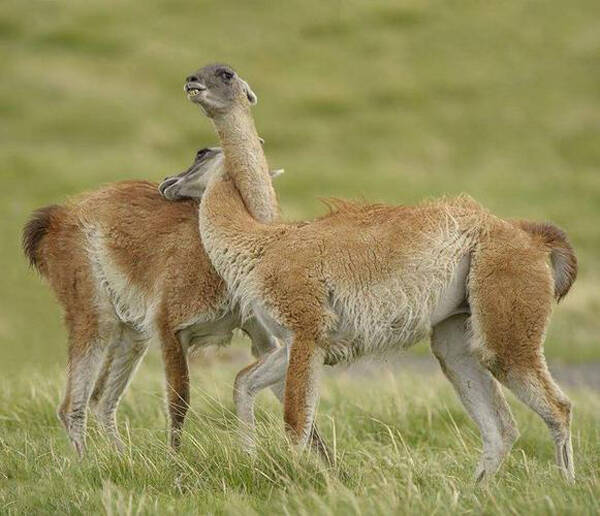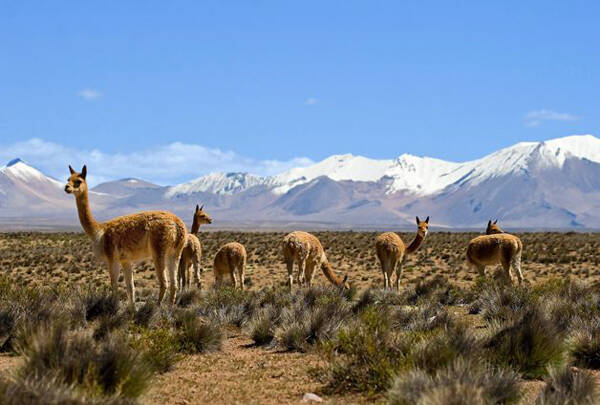Vicugna vicugna
IUCN
LCBasic Information
Scientific classification
- name:Vicugna vicugna
- Scientific Name:Vicugna vicugna,Vicuna
- Outline:Ungulata
- Family:Artiodactyla Camelidae Vicuna
Vital signs
- length:125-190cm
- Weight:35-45kg
- lifetime:15-20years
Feature
Among alpaca wool, vicuña wool is the thickest and longest, but has poor elasticity.
Distribution and Habitat
Vicuñas are distributed in Argentina, Bolivia, Chile, Peru and Ecuador.
Vicuñas prefer high altitudes and cold weather, and mostly live on mountains 4,000-5,000 meters high, especially the majestic Andes Mountains, which are their home.
Appearance
The llama is 125-190 cm long, 70-110 cm high at the shoulder, 15-25 cm long tail, and weighs 35-45 kg. It is the smallest member of the camel family, and the llama is considered to be the ancestor of the wild alpaca. Its neck and chest are like a camel, its body is like a pony, and its temperament is gentle. It has a large, wedge-shaped head, large ears, triangular eyes, a long neck and legs, and it is good at using the soles of its feet and toes to gain a more stable footing on rocks and gravel. The llama's hair is long and soft, and its colors are pure white, black, tan, etc. The fur on the head ranges from yellow to reddish brown, blending into a pale orange at the neck. There is a 30 cm long, silky white mane covering the chest, and the fur on the rest of the body is soft and uniform in length. The back is light brown, and the abdomen and sides are dirty white.
Details
Llama (scientific name: Vicugna vicugna) is also known as Vicuna in English. It has three subspecies and is a large mammal.

The llama is a unique animal on the semi-arid grasslands at an altitude of 3,500 to 5,750 meters in the Andes Mountains of Peru, Bolivia, Argentina and Chile. It can carry goods on the mountains with thin air. Its meat can be eaten, its skin can be made into leather clothes and leather hats, and its hair can be made into woolen fabrics.
The gestation period of female llamas lasts 330 to 350 days, and only one calf is born. The entire birth process takes 15 minutes from the birth of the calf. The calf can stand and walk after birth. The female llama is responsible for raising the calf for the next four to nine months. After 10 months, sub-adult females stay in the group. Sub-adult males leave the group, either alone or joining a group of single male llamas. Sexual maturity occurs in one year, and the life span is 15-20 years.

According to historical records, llamas and Indians had a close relationship very early. The ancient Indians used llamas as the best tribute and regarded them as sacred animals. Hunting and slaughtering were absolutely prohibited. Only on June 24th of each year, when the sun god was worshipped, the whole llama was thrown into the rivers and lakes during the grand prayer ceremony. By the first half of the 16th century, there were more than 1.5 million llamas in Peru alone. However, since the invasion of South America by new and old colonialists, llamas have been hunted indiscriminately, and their numbers have been greatly reduced. There are only more than 50,000 llamas left in the entire South America. The reason why the llama suffered such a bad fate is that it is a precious economic animal. In particular, its soft fur with bright colors and tough fibers - "Lala hair" (as Peru has always called it) brings a large amount of foreign exchange income to these countries every year, making it a leader in the world animal hair market. Each llama can shear about 1 kilogram of wool a year, and the fiber is up to 7 cm long. It is a high-quality raw material for the wool textile industry and enjoys a high reputation in the international market. Peru has a kind of shawl made of llama wool - "Poncho", which is inlaid with various beautiful patterns and designs, and has a round hole in the middle that can be put on the neck of a person. It is the most popular thing for Peruvian men, women, old and young to wear to keep warm.
The llama has sounded the clarion call for "protection" in Peru and other countries. The government has begun to stipulate protection regulations prohibiting the killing of llamas, and has implemented severe punishment measures for all those who kill llamas. Today, the llama is regarded as a "national symbol" in Peru. A dignified and gorgeous pattern is inlaid on the red and white Peruvian national flag. A light brown llama stands in a corner of the pattern, which looks particularly elegant and agile against the blue sky. In addition, the image of llama is often drawn on Peruvian coins and trademarks.
How to domesticate the wild ruminant llama into a domestic animal has long been a problem that livestock experts have paid attention to. Long before the Spanish colonialists came to America, the llama had become the only pack animal there. According to historical records, there were no horses, cattle, or even any large livestock in South America since the 16th century. Therefore, at that time, people relied on llamas to carry things, in addition to human labor. It can be seen that llamas have made indelible contributions in the history of America.
Listed in the "World Conservation Union" (IUCN) ver.: 2008 Red List of Mammals - Low Risk (LC).
Protect wild animals and eliminate game.
Maintaining ecological balance is everyone's responsibility!








